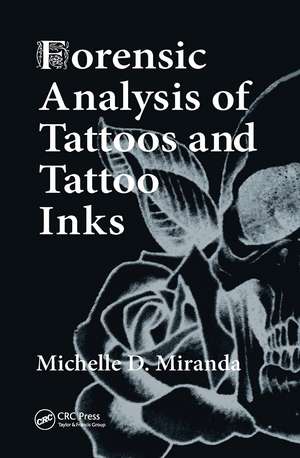Forensic Analysis of Tattoos and Tattoo Inks
Autor Michelle D. Mirandaen Limba Engleză Paperback – 31 mar 2021
This book provides an understanding of the process of tattooing and the roles of tattoos in criminological inquiry and legal matters. It scientifically evaluates tattoo inks, documenting the physical properties of the inks both macroscopically and microscopically as well as spectroscopically—identifying the optical and chemical properties of the various pigments found in these inks. A thorough analytical method is developed to conform to current laboratory accreditation standards and the satisfaction of legal standards such as Frye, Daubert and the Federal Rules of Evidence.
Forensic Analysis of Tattoos and Inks shows how routine scientific inquiry can be applied to tattoo evidence by adding an objective component to interpretation, identification, and individualization of tattoos and tattoo inks in investigations. It presents the science and chemistry of tattoos and tattoo inks as a reliable tool in forensic casework and other related criminal and legal matters.
Preț: 432.63 lei
Preț vechi: 555.29 lei
-22% Nou
Puncte Express: 649
Preț estimativ în valută:
82.79€ • 89.90$ • 69.55£
82.79€ • 89.90$ • 69.55£
Carte tipărită la comandă
Livrare economică 22 aprilie-06 mai
Preluare comenzi: 021 569.72.76
Specificații
ISBN-13: 9780367778439
ISBN-10: 0367778432
Pagini: 382
Dimensiuni: 156 x 234 mm
Greutate: 0.71 kg
Ediția:1
Editura: Taylor & Francis
Colecția CRC Press
Locul publicării:Oxford, United Kingdom
ISBN-10: 0367778432
Pagini: 382
Dimensiuni: 156 x 234 mm
Greutate: 0.71 kg
Ediția:1
Editura: Taylor & Francis
Colecția CRC Press
Locul publicării:Oxford, United Kingdom
Public țintă
Academic and Professional Practice & DevelopmentCuprins
TATTOOING HISTORY. Tattoos and Tattooing. Tattoos and Tattooing in Criminology and Criminal Investigations. Tattoo Modification, Removal, and Detection. TATTOO INKS AND TATTOOING HISTORY. Tattoos and Tattooing. Tattoos and Tattooing in Criminology and Criminal Investigations. Tattoo Modification, Removal, and Detection. TATTOO INKS AND PIGMENTS: HISTORY AND CHEMISTRY. General Components of Tattoo Inks. The Chemistry of Tattoo Inks from Ancient to Modern Times. Alternate Sources of Tattoos and Tattoo Inks. MODERN TATTOO INKS. Modern Organic Pigments. The Chemical Analysis of Modern Tattoo Inks: Microscopy. The Chemical Analysis of Modern Tattoo Inks: Spectroscopy. FURTHER STUDIES AND CONCLUSIONS. Current Status and Future Work.
Notă biografică
Michelle Miranda holds a PhD in criminal justice with a forensic science concentration and an MPhil in criminal justice from The CUNY Graduate Center. Dr. Miranda is a diplomate with the American Board of Criminalistics and a member of the American Academy of Forensic Sciences. She worked as a criminalist in the Trace Evidence Section of the NYPD crime lab, and as both a medical photographer and a death investigator for regional medical examiner’s offices in New York State. She is an adjunct assistant professor at John Jay College of Criminal Justice and is currently employed as an assistant professor in the Department of Security Systems and Law Enforcement Technology at Farmingdale State College (SUNY).
Recenzii
"The literature within the forensic domain is limited in this area. The text gathers together much of this and as such acts as a useful reference." - Niamh NicDaeid, Springer, Analytical and Bioanalytical Chemistry
Descriere
This book provides an analysis of tattoo inks and uses of tattoos as a tool in forensic investigations and criminalistics. It covers the history of tattoos and tattoo inks, including the use of tattoos as aids in identification of individuals. This includes cases of charred, decomposed, mummified or otherwise unidentifiable remains. It explains
